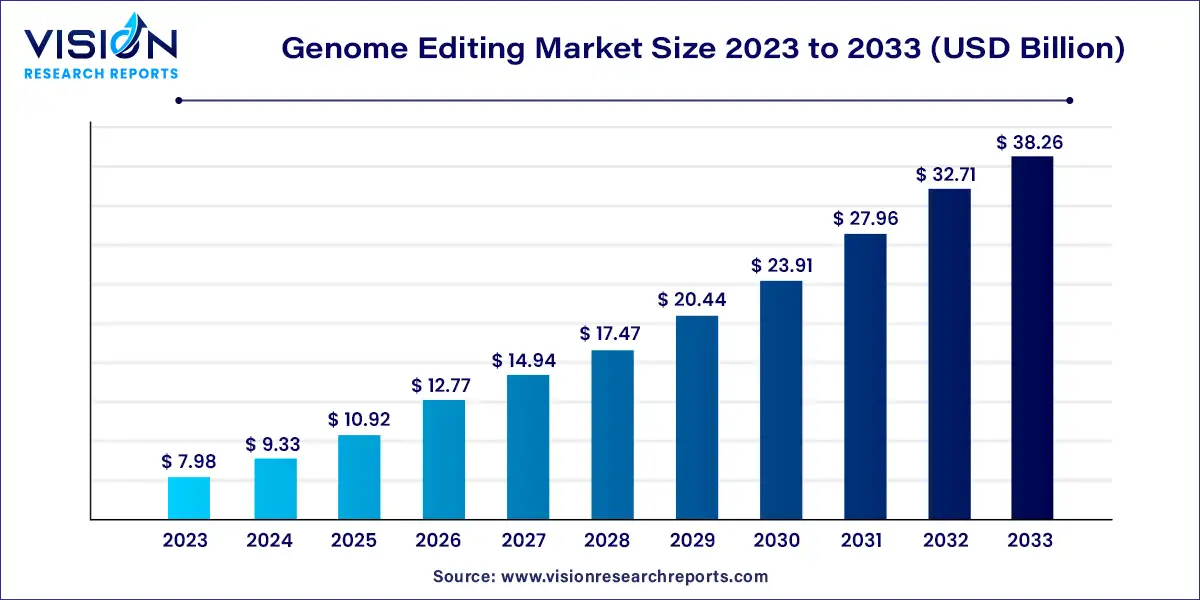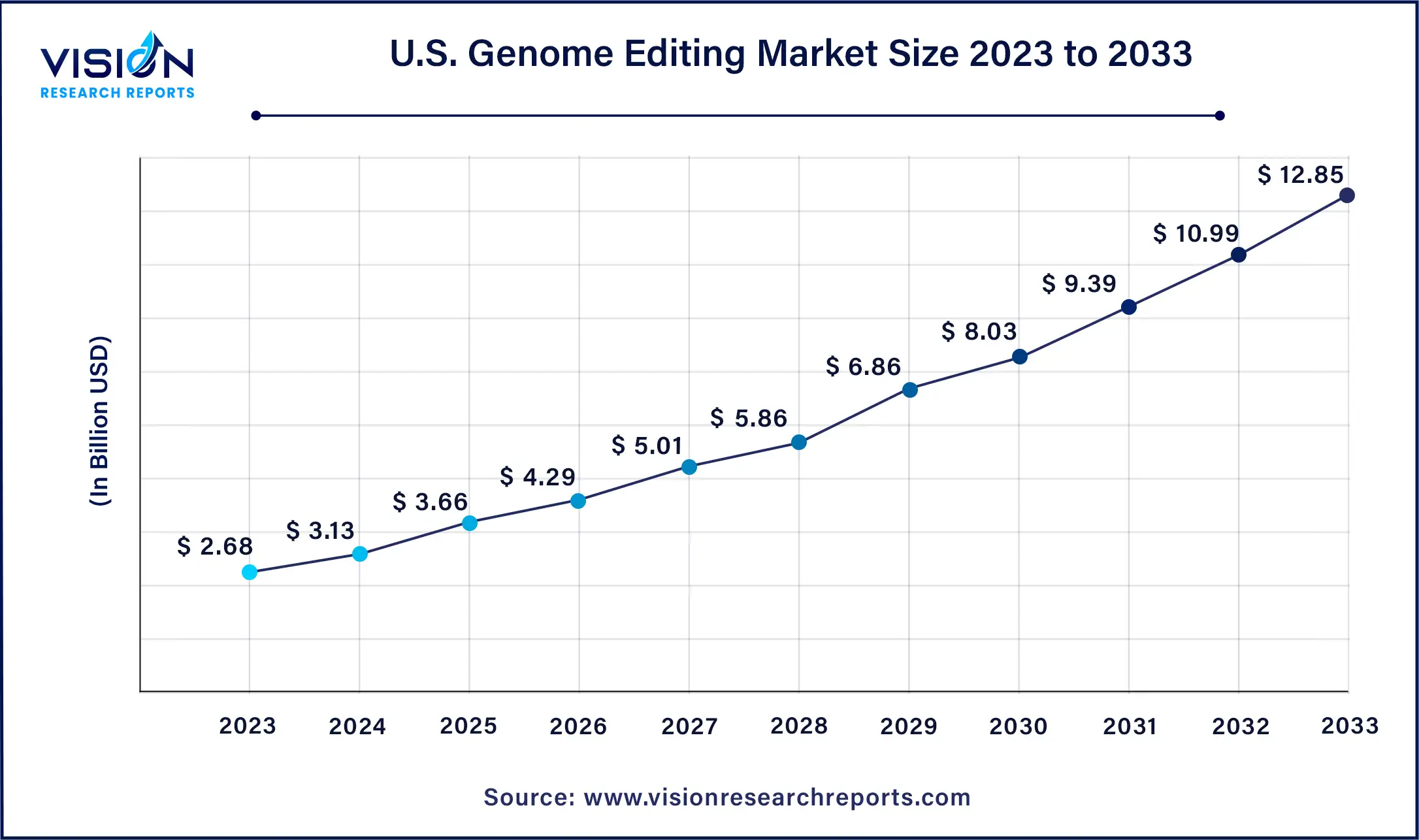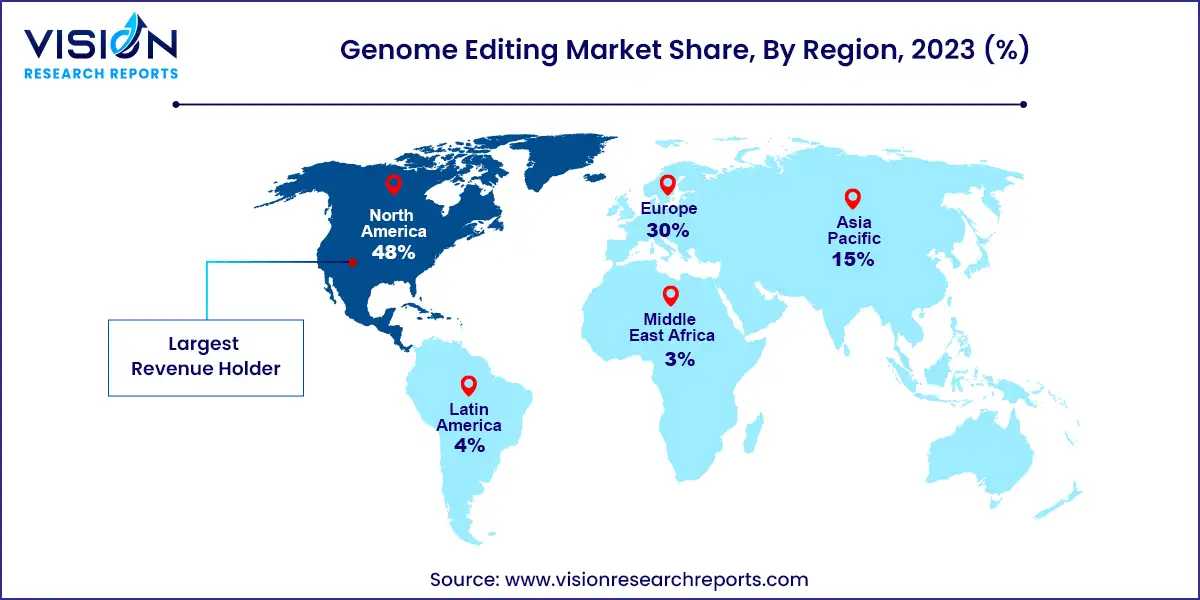The global genome editing market size was estimated at USD 7.98 billion in 2023 and is expected to surpass around USD 38.26 billion by 2033, poised to grow at a CAGR of 16.97% from 2024 to 2033.

Genome editing, also known as gene editing, refers to a set of technologies that enable scientists to alter an organism's DNA. These technologies allow for the addition, removal, or modification of genetic material at particular locations in the genome. The advancements in this field have opened up numerous possibilities across various sectors, including healthcare, agriculture, and biotechnology.
The growth of the genome editing market is fueled by an advancements in technology, particularly the development of highly efficient and precise genome editing tools like CRISPR-Cas9, have accelerated research and applications across various sectors. Additionally, increasing investment in research and development activities by both public and private entities has contributed to expanding the scope and capabilities of genome editing techniques. Moreover, the rising prevalence of genetic disorders and the need for effective treatments have spurred demand for genome editing in the healthcare sector.
The U.S. genome editing market size was estimated at around USD 2.68 billion in 2023 and it is projected to hit around USD 12.85 billion by 2033, growing at a CAGR of 16.97% from 2024 to 2033.

The presence of robust research infrastructure, a rise in genetically modified crops, and an increase in the prevalence of genetic diseases are some of the major factors boosting the U.S. genome editing market’s growth. Moreover, in the U.S., genetic diseases such as cystic fibrosis are prevalent. On the other hand, a rise in the number of patent approvals for U.S.-based companies has also accelerated the adoption of genome editing tools in the country, leading to positive market growth.
North America dominated the market and accounted for a 48% share in 2023 owing to the growing investments in the R&D of gene editing technologies. Due to the presence of several biotechnology and pharmaceutical companies working on developing genome editing technologies, the region is projected to maintain its dominance over the projected period.

Asia Pacific is anticipated to witness the fastest growth at a CAGR of 18.76% from 2024 to 2033. The regional market growth is expected to be driven by the increasing demand for gene editing technologies and the rising prevalence of genetic disorders and diseases across countries like India and Australia. Moreover, the domestic companies providing gene editing products and services are attracting investments and funding. For instance, in April 2021, GenScript launched Research-Grade Lentiviral Vector Packaging Service for drug discovery, cell line development, and gene editing.
The CRISPR/Cas9 segment held the largest market share of 44% of the global revenue in 2023. This can be attributed to high precision & efficiency, high versatility & adaptability to different experimental designs, and cost-effectiveness with relatively low expense associated. In addition, with the growing number of applications, the demand for CRISPR is anticipated to grow over the forecast period. The clinical applications of CRISPR have been widely accepted. This is evident from the increasing number of ongoing clinical trials using gene-editing techniques for the treatment of a wide range of diseases such as AIDS, cancer, and genetic diseases. In addition to human health, this technology is witnessing increasing usage in agriculture and animal breeding applications.
The ZFN segment is expected to witness a substantial CAGR of 16.57% over the forecast period. Zinc Finger Nuclease (ZFN) is a widely used technology in the field of genome editing. It is a kind of engineered nuclease that facilitates targeted modifications in DNA strands. ZFNs or homing endonucleases have been successfully used to target HBV, HIV, human papillomavirus, herpes simplex virus type, and human T-cell leukemia virus types, as these are susceptible to transcriptional suppression and gene disruption by ZFNs. Moreover, lower off-target activity does aid in gaining the approval for ZFNs as therapies. As a result, the technique is anticipated to hold immense economic potential for developing gene therapies in the coming years.
The ex-vivo segment dominated the market with a share of 52% in 2023. This dominance can be attributed to the ease of control in DNA modification provided along with the precise regulation of strength and duration of nuclease expression to minimize off-target editing and maximize efficiency. Ex-vivo products such as CAR-T technology for oncology blood treatment are observed to be prioritized in the therapeutic molecular scissors pipeline.
The in-vivo segment is projected to witness the fastest growth at a CAGR of 19.95% from 2024 to 2033. Many specialized cell types cannot be removed from the patient and maintained alive outside the body for the duration of the treatment or cannot be effectively returned to the patient after treatment (e.g., heart muscle cells, specialized neuronal cells). Therefore, the development of several in-vivo genome editing techniques is expected to drive market growth in the near future.
The genetic engineering segment held the largest market share in 2023. The segment is further categorized into cell line engineering, animal genetic engineering, plant genetic engineering, and others. The use of gene therapy for developing novel molecules for the treatment of diseases such as lymphoma, sickle cell, and infectious diseases is anticipated to boost the adoption toward the end of the forecast period.
The clinical applications segment is expected to grow at a significant CAGR of 13.20% over the forecast period. Clinical applications of genome editing include diagnostics and therapy development. The demand for such applications is primarily driven by their potential to address genetic diseases. Genome editing offers the prospect of precise and personalized treatments tailored to an individual's genetic makeup, which helps in advancing therapeutic development. Furthermore, advancements in genome editing technologies, coupled with an increase in understanding of the genetic basis of diseases, have fueled interest in the development of novel diagnostic tools, thereby driving the segment.
The contract segment dominated the market in 2023 due to the high extent of outsourcing activities in the genomics space driven by the lower costs and greater flexibility in operations offered by such activities as compared to in-house development. The segment is projected to witness further growth because of the increasing strategic activities undertaken by outsourcing service providers. For instance, in December 2022, a CRO named Crown Bioscience, Inc. collaborated with ERS Genomics Limited to gain access to ERS’ CRISPR/Cas9 patent portfolio and strengthen its market presence in the gene editing space. Such initiatives are expected to boost the outsourcing opportunities in the genome editing domain and can positively impact market growth.
The in-house segment is expected to witness lucrative growth over the forecast period due to the ownership of supply channels, better troubleshooting abilities, and enhanced potential for future in-house scale-up activities. Hence, companies such as Precision BioSciences maintain internal manufacturing facilities compliant with current Good Manufacturing Practices (cGMP) to produce genome-edited products, including allogeneic CAR T cell therapies. These factors are anticipated to drive the revenue growth for the segment over the forecast period.
The biotechnology and pharmaceutical companies segment accounted for the largest market share of 51% in 2023. The presence of a growing number of research activities for novel therapeutic development is the major factor contributing to revenue generation. Moreover, global pharmaceutical companies are collaborating with emerging companies to develop novel technologies. Increased research development efforts for novel treatments are the main factor fueling revenue growth. With rapid advancements in DNA engineering technology such as the introduction of the CRISPR/Cas9 system, the process of creating knockout/knock-in transgenic in microorganisms, plants, and animals, including humans, has become very simple, easy, efficient, accurate, and less time-consuming.
The academic and research institutions segment is expected to grow at the fastest CAGR of 19.23% over the forecast period due to the increasing usage of genome editing technology in academic settings such as college campuses. Several organizations are developing lessons for high school and college students to better understand gene editing techniques.
By Technology
By Delivery Method
By Application
By Mode
By End-use
By Region
 Cross-segment Market Size and Analysis for
Mentioned Segments
Cross-segment Market Size and Analysis for
Mentioned Segments
 Additional Company Profiles (Upto 5 With No Cost)
Additional Company Profiles (Upto 5 With No Cost)
 Additional Countries (Apart From Mentioned Countries)
Additional Countries (Apart From Mentioned Countries)
 Country/Region-specific Report
Country/Region-specific Report
 Go To Market Strategy
Go To Market Strategy
 Region Specific Market Dynamics
Region Specific Market Dynamics Region Level Market Share
Region Level Market Share Import Export Analysis
Import Export Analysis Production Analysis
Production Analysis Others
Others